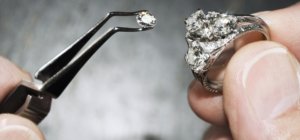 Jewelry is made by a variety of different manufacturing processes. Have you ever wondered why jewelry is described as handmade as often as not? What exactly goes into a piece of jewelry after metal ore and gemstones come out of the earth? The answers are as complex as the jewelry itself.
Jewelry is made by a variety of different manufacturing processes. Have you ever wondered why jewelry is described as handmade as often as not? What exactly goes into a piece of jewelry after metal ore and gemstones come out of the earth? The answers are as complex as the jewelry itself.
How is custom jewelry made?
Here, we will illuminate some of the processes that go into making jewelry whether it is one piece at a time or production runs of thousands.
Mining:
Jewelry in essence begins at the mine. Metal ore is extracted from the earth and gemstones are freed from their matrix. While much of the precious metal in circulation is refined and recycled, at some point in its history, it was mined from the earth. Gemstones may trade hands many times over, but first they are mined. Large scale mines can be environmentally disrupted while smaller artisanal mines have a very low impact on their surroundings.
Lapidary:
Gemstones come out of the earth in their original crystalline structure. It is the art of lapidary that brings out the full potential of beauty in a gem. Gemstones can be cut, shaped, faceted, and polished losing a large percentage of their original carat weight.
Fabrication:
Jewelry fabrication refers to the manipulation of mill products such as sheet, wire, and tubing to create handmade jewelry. Fabrication is an additive process by which the structure is built up by individual components. The traditional goldsmith will even create mill products from grains of pure precious metals by alloying the precious metal to the desired fineness, or karat.
Wax Carving:
Wax carving is a subtractive process where a jewelry model maker begins with a solid piece of wax and carves into it much like a sculptor. Jeweler’s wax can also be used similarly to fabrication methods, as wax models can be made from wax sheet and wax wire as well. Waxes are very delicate, often cast directly into metal for a one of a kind piece or to create a metal prototype.
Casting:
A process by which multiple pieces of jewelry can be made at one time, casting replaces a wax form with metal. Referred to as “lost wax casting” the steps include mold making, wax injection, investing, burn out, casting, and finishing. Casting is commonly used for single one of a kind pieces as well as large volume production.
Die striking:
Die striking uses metal molds through which metal is pushed by pneumatic force. The advantages of die striking include great uniformity in pieces and durability of the metal molds used. Many jewelry components such as settings for stones and clasps are made by die striking. Metal molds are expensive to produce, so this method is suitable for large volume production.
Soldering:
When a piece of jewelry consists of multiple components, they are often connected through soldering. A jeweler will use a torch to heat the components and then introduce a filler material, usually a similar precious metal alloy with a slightly lower melting temperature to create a bond. The resulting connection is called a solder joint and is a common way to create jewelry. Soldering can be done by hand with a torch or in large batches in a high temperature oven called a kiln.
Laser Welding:
Sometimes, it is not possible to solder on a piece of jewelry. Dissimilar metals or vulnerable gemstones make laser welding an attractive alternative method of joining or repairing jewelry components. An acronym for light amplification by stimulated emission of radiation, lasers are now widely used in jewelry making for a variety of applications included repairing porosity in castings, joining components, and repair to name a just a few.
Stone setting:
Commonly done by hand, it is possible for calibrated gemstones to be set mechanically as well. Stone setting varies in its complexity, but most jewelry will contain one or more of five dominant stone setting techniques: prong setting, bezel setting, pavé setting, channel setting, and flush setting. Each one f these different techniques has multiple variations within them.
Finishing:
The final look of a piece of jewelry is achieved by its finish. Common finishing techniques include high polish which imparts a bright luster, satin or matte finish which is more subtle and good for pieces with texture, oxidation, which gives an antique appearance, and patina which brings out colorful surface treatments in the metal. Finishing is often done by hand but can also be done mechanically in large batches by a process known as tumbling.
How long does it take to make Custom Jewelry?
Depending on the design, the availability and selection of gemstones and metal, a custom ring creation can take between 4-6 weeks. Your piece of jewelry has likely been created through several of the above mentioned processes. Gems mined from the earth, cut and polished by a lapidary can be set into a hand fabricated ring soldered together with die struck components. Did you ever consider how complex jewelry making can be? Does it give you a deeper appreciation for what you can expect to pay for your jewelry? We are curious to know.
